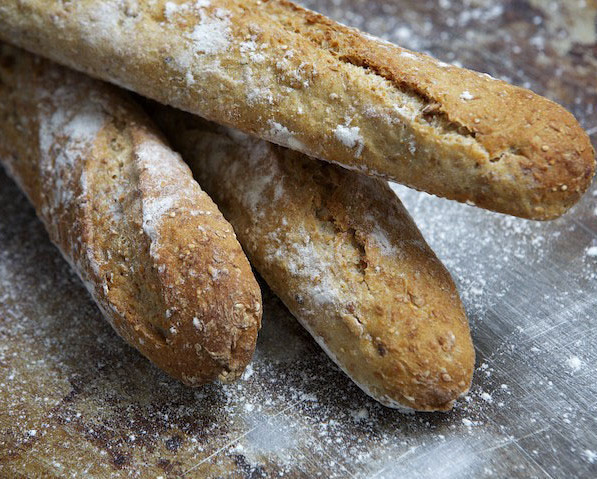Here’s the recipe: One heaping serving of grains from Shipton Mill, some Fresh Ginger, and a few ovens pre-set to 220 degrees. What does that make you? Maddie Salters shares her thoughts from her hands-on baking experience with Bake With Maria in South Hampstead.
The Baking Lab, a converted rooftop loft that crosses modern London cool with tried-and-tested French and Scandinavian baking tradition, is known for its creative lessons, intimate class sizes, and yes- delicious bread. While owner Maria Mayerhofer has been kneading dough alongside her students for five years now to create crusty baguettes and tangy sourdoughs, she also likes to stir things up outside of the stand mixer. From her pizza-and-beer bake-a-thons to her evening macaron workshops, Maria is always looking for what she can offer students to engage the mind as well as the taste buds.
On that note, she teamed up with Health Coach and style-guru Josie Taylor of The Fresh Ginger and the organic growers at Shipton Mill to put together a special lecture class on the topic of gluten in breads and baking.
Being lucky enough to attend the workshop, I nonetheless had a little trouble locating the venue by nightfall. (For the record, it’s right across from South Hampstead Overground Station, where you loop around a gate to an unassuming door cut into brick facing that leads up two darkened stairwells to the rooftop corridor.) Well worth the trouble with Google Maps, The Baking Lab opens like a hearth. Cosy and warm, tea and a sampling of financiers awaited me on my way out of the dank weather, and I sat down to a few hours of hands-on baking and learning.
What I found out may come as a surprise: Gluten, grocery counter villain-of-the-week, has been miscast. While there are people who certainly do have allergies to it, the outright “food fundamentalism” of the latest gluten-free crazes may not be asking the important question: what actually is gluten? A natural protein found in grains, the type and amount of gluten you’re consuming depends the wheat crops themselves, how they were grown and processed. People who have mild gluten sensitivities (or, who might want to cut down on gluten for health reasons) may have options outside of going cold turkey. While breads in the bakery aisles of most major supermarkets have been made from highly processed flours from chemically manipulated plants, baking at home offers options. Bread and cakes made with spelt flour, for example, are using the most water-soluble form of gluten, which can be digested more easily. Sour Dough bread breaks down gluten for much the same result. Organic flours also may make gluten more palatable, as modern pesticides contain enzyme inhibitors that sink into the soil and make processing difficult on our bodies by inhibiting our own enzymes when we consume them. Some grain types; and there are 126 kinds for making flour; can be consumed by gluten intolerant people after a proofing.
This was demonstrated to us during an interactive gluten wash. We literally rinsed everything but the gluten out of a number of pre-made doughs in cold water, allowing us to see, touch, and smell gluten- before baking it. That’s right! Step one was making bread-free gluten, instead of gluten-free bread. (For the record, the gluten-only doughs cooked into extremely puffy, flaky crusts that tasted exactly like chicken skin. Vegans, we may be on to something here!)
After with the lecture, we were able to roll our sleeves up and indulge in a little bread baking ourselves. We completed the no-mess, no-fuss Overnight Rye Bun recipe, and ladled out a pre-made batch onto baking sheets with a soaked spoon (to prevent sticking.) Using honey rather than sugar to get a crisp, caramelised outer shell, these little lumps of joy were really the show-stealer. Still, to keep things traditional and healthy, we kneaded, shaped, and scored Multigrain Baguettes. Having something to enjoy on-site and something to take away for later created a communal experience, while giving everyone something to look forward to the following day.
With organic flour provided by Shipton Mills (the artisan millers who supply Jamie Oliver), and a little help from the Bake With Maria staff, the air was soon smelling sweet with our finished creations.
Nestled among the clean wooden counters, vintage nicknacks, and stand mixers that hinted at more advanced classes; a vibe that blended trendy soho upmarket with a grandmum’s sitting room; we sat to our fresh-from-the oven breads. Rye with fig and fennel, sour dough, and our Overnight buns were livened up with cream cheese, hummus, and a beat spread with a spicy kick. Served up with tea and lemonade, this feast of a finale gave participants some time to chat, ask questions, and naturally, Instagram.
A delicious and informative evening all around.
So, some final tips straight from the kitchen? Don’t let your yeast and salt touch while you’re baking, the salt can kill the yeast. Put some water in a pan on the grate beneath your bread while it bakes to keep the crust light. Knead dough with your fingertips, as your palms may be too warm for the yeast. Kneading and rolling on wooden tops is better than granite, because wood retains warmth better. And if you want to learn a bit more about how to become your family’s boulanger, definitely think about booking a class.
Taking my own advice, I’m heading back to The Lab soon to try out their French breads class, so more tips and tricks to come!
The Baking Lab is located at 81 Loudoun Road, NW8 0DQ. Find out more at bakewithmaria.com.






















